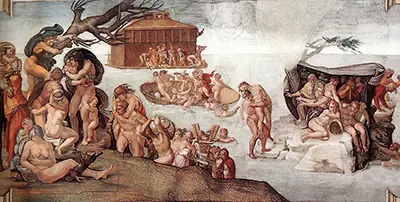Comprising thirty three different panels in all, it is the central section of nine panels, depicting the story of Genesis which lie at the heart of the ceiling; and which could be considered Michelangelo's masterwork.
The Deluge is the second of these panels, and tells the story of the Great Flood, when God drowned the Earth, save the occupants of Noah's Ark; which is visible here in the background, floating away on the rising waters.
The Old Testament is a rawer, more violent text than the New, and Michelangelo here doesn't shy away from the notion of a vengeful God. The painting is a writhing mass of energy, as naked figures seek to escape the rising waters; the painting effectively conveys the sense of panic with muscular brushstrokes detailing the contorted forms of the doomed people.
Everywhere one looks in this painting there is desperation, a knot of figures in the left foreground climbing a barren rock (and in one case a blasted, bare-limbed tree, surely the tree's lack of leaves being a nod as to how life is leaving the world) is mirrored in on the right by another group clustering under a rudimentary shelter.
In the centre of the picture is the most hopeless scene of all, a group in a boat which is visibly in the middle of capsizing - surely a metaphor for man's powerlessness in the face of almighty God.
The only ones to be saved are those on the Ark, which can be seen here still being frantically worked upon, God's retribution perhaps coming a little earlier than Noah expected.
But is he doing something else here? The scene is so despairing, and the destruction so obviously imminent, that the viewer is bound to question the rightness of such vengeance.
Certainly the life-loving Michelangelo's relationship with the Church was at times difficult to reconcile with his hedonistic tendencies (in later years El Greco was to consider him insufficiently Christian), he didn't want to paint the Sistine Chapel ceiling, being busy at the time on the tomb of Pope Julius II's tomb, and considering himself to be more of a sculptor than a painter. Elements of this work can lead us to the French Romanticists of several centuries later such as Eugene Delacroix and Theodore Gericault.
He even wrote a poem detailing what an unpleasant experience it was. Set in this context, is it possible that the visceral nature of this painting is intended to invite criticism? To make the viewer question the justness of God's actions?
Whatever Michelangelo's motivation, what is unquestionable is the power of this painting. Its energy is almost as overwhelming as the water. The use of colour is masterly, the waters are an unforgiving white and grey rather than picture perfect blues.
This furious, stormy blankness is the perfect backdrop for the vivid flesh tones of his people as they attempt fruitlessly to escape. Bodies are depicted with Michelangelo's usual anatomical precision, and his eye for the beauty particularly of the male form. The human parts of the painting are full of action, bodies packed densely together, the level of detail is incredible.
But perhaps the most touching aspect of the Deluge is the image of a man tenderly holding the drowned body of another, presumably his son. Thus we have an act of love in the midst of a painting about retribution. As to whether that stands for divine love or the more human kind is up to the viewer to judge.


